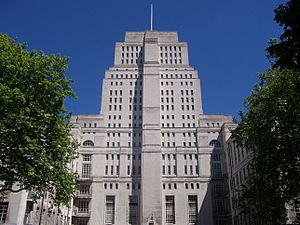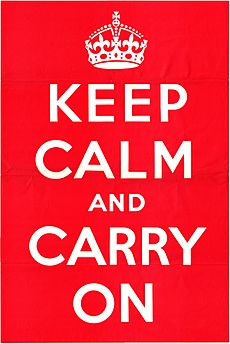Ministry of Information (United Kingdom) facts for kids

The Ministry of Information (often called MOI) was a special department of the United Kingdom government. It was created for a short time during the end of World War I and then again during World War II.
During the 1940s, the MOI was located in Senate House at the University of London. Its main job was to handle all government publicity and propaganda. This meant sharing information and messages with people in Britain and other countries. The MOI closed down in March 1946. Its remaining tasks went to a new group called the Central Office of Information (COI).
Contents
The First World War MOI
Before 1917, there wasn't one main group in charge of sharing public information or controlling what news was shared (censorship). Many different departments were doing similar things.
For example, there was a group for films called the British Board of Film Censors. There was also the Propaganda Bureau, which shared information overseas to counter what Germany was saying. Another group, the National War Aims Committee, focused on sharing information inside Britain.
In 1914, the Propaganda Bureau started its work. It even hired 25 famous writers, including John Buchan. Later, in 1917, this department was reorganized and became the Department of Information. It was then renamed a ministry. Important leaders like Lord Beaverbrook were in charge. Some people worried that this was the government trying too much to control the news.
Even after the war, different groups kept arguing about how information should be handled. However, by 1918, the Press Bureau created rules for sharing information during wartime. These rules were later used in 1938 to help set up the Ministry of Information for the Second World War. Some news control continued until 1920.
The Second World War MOI

The Ministry of Information (MOI) was officially formed on September 4, 1939, just one day after Britain declared war. Its main goal was to "promote the national case to the public at home and abroad in time of war." This meant creating "National Propaganda" and controlling news and information.
The MOI was in charge of:
- Controlling what news was released (censorship).
- Giving out official news.
- Handling publicity inside Britain.
- Managing publicity in Allied and neutral countries.
They also watched what people thought by having offices in different regions.
Planning Before the War
Secret plans for the MOI began in October 1935. Experts wanted to use lessons from the First World War and new communication tools. They believed that government messages would be needed to keep people's spirits up during a future war.
However, planning was difficult. Different groups had different ideas for the ministry. Also, many government departments did not want to give up their own public relations teams.
The MOI and Czechoslovakia
The shadow (unofficial) Ministry of Information was briefly active from September 26 to October 3, 1938. This happened when Nazi Germany took over part of Czechoslovakia, causing high international tension. During this time, 71 officials worked to control news reports about the Munich Agreement.
This short test did not go well. It showed that many problems still needed to be solved, like where the ministry would be located and how it would work with the media. The British Prime Minister, Neville Chamberlain, announced the government's plans for the MOI in June 1939.
The "Phoney War" Period
The MOI officially started on September 4, 1939. Lord Macmillan became its first minister. The MOI's main office stayed at University of London's Senate House throughout the war.
The MOI was first divided into four main groups:
- "Press Relations" handled news and censorship.
- "Publicity Users" (for foreign and home) created propaganda policy.
- "Publicity Producers" (for different media) handled design and creation.
- "Co-ordination and Intelligence" managed everything.
The press was not happy with the MOI at first. They complained that the MOI was too slow in releasing news and that censorship was too strict. Some people also made fun of the ministry for having too many staff and being out of touch. The MOI's first poster campaign, "Your Courage, Your Cheerfulness, Your Resolution, Will Bring Us Victory," was also criticized.
Because of these problems, the Press Relations Group was removed in October 1939. The MOI also cut its staff by one-third. Sir John Reith took over as minister in January 1940. He tried to make the MOI work better and created a "Home Intelligence" division to understand public opinion.
The Battle of Britain
When Winston Churchill became Prime Minister in May 1940, Duff Cooper was appointed as the new Minister of Information. As Nazi forces advanced in Europe, the MOI focused more on messages for people in Britain.
An emergency committee was set up to give instructions about air raids and what to do if an invasion happened. Campaigns also told people to "Avoid Rumour" and join a "Silent Column" to prevent sharing information with spies. However, some people felt these campaigns treated the public like they were not smart.
In July 1940, the MOI faced more criticism. People accused it of using "Gestapo" (secret police) tactics to spy on the British public. Newspapers called the MOI staff "Cooper's Snoopers" because they were doing opinion polls. Many felt that the British government was becoming too much like the enemy they were fighting.
Duff Cooper also tried to get more control over other government departments' public relations. This led to arguments with Churchill. After many disagreements, Brendan Bracken replaced Cooper as Minister in July 1941.
Later Years of the War
The Ministry of Information became more stable under Brendan Bracken. He had Churchill's support and stayed in office until after Victory in Europe Day.
Bracken helped the MOI work better with other government departments. He believed the MOI should not stop people from speaking freely. He also wanted the MOI to have a smaller role in creating messages for people in Britain. He felt the MOI should provide background information and technical support to other departments, rather than "lecturing" the public. Bracken also insisted that the MOI should close down after the war with Germany.
After the War
The MOI was officially closed in March 1946. Its remaining duties were passed to the Central Office of Information (COI), which provided common information services for the government.
MOI Campaigns
The MOI created campaigns about many different topics, including:
- Life on the Home Front (what people in Britain were doing during the war).
- Production and Salvage (encouraging people to make things and recycle).
- Allied Unity (showing how different countries worked together).
- The Fighting Forces (highlighting the soldiers, sailors, and airmen).
- Important Personalities (featuring leaders and heroes).
How the MOI Worked
For publicity within Britain, the MOI planned government information and helped other departments with their public relations. The Home Publicity division ran three types of campaigns: those asked for by other departments, specific regional campaigns, and those it started itself. Before a campaign, the MOI made sure that propaganda was not used instead of real actions or laws.
The General Production Division (GPD) did a lot of the technical work. They often created posters and other materials very quickly. Many artists were called back from military service in 1942 to work for the ministry. In that year, about £4 million was spent on publicity. Many famous artists, like Eric Kennington and Paul Nash, worked as war artists for the MOI.
The MOI also collected feedback on how people felt about the war and the publicity. The famous writer Dylan Thomas also helped by writing scripts for at least five films in 1942, including This Is Colour and New Towns for Old.
See also
- Paper Salvage 1939–50
- Political Warfare Executive – A British propaganda unit during World War II.
- Ministry of Truth – A fictional version of the MOI in the book Nineteen Eighty-Four.
- War Artists' Advisory Committee
- Central Office of Information
Images for kids
-
Lord Beaverbrook, a Minister of Information during World War I.



